This site uses cookies as defined in our Cookie Policy, by continuing to use this site you agree to their use.
Continue
| Arrive | Depart | ||||||
| 15th15 | AprApr | 202626 | Santa Cruz de Tenerife, Spain, embark on the Emerald Sakara | ||||
The largest of the Canary Islands, Tenerife is a beautiful and scenic island which enjoys year-round sunshine and is dominated by Mount Teide. The mountain range runs through the centre of the island, with fertile valleys on the northern side. In the central part of the range is the gigantic natural crater of the Cañadas del Teide, about 14 miles in diameter. Santa Cruz, the island’s pretty capital, was originally a small fishing village but has now grown into a modern city, and also contains 16th-century civic buildings and ornate private mansions. Near the pier is the Santa Cruz Palmetum, a Botanical Garden covering an area of 29 acres, specialising in palms. Your cruise begins in Spain’s Canary Islands and Santa Cruz de Tenerife, a port city on the island of Tenerife, where you’ll be transferred to your Emerald Cruises luxury yacht for the start of your marvellous voyage along the Spanish coastline. Please book your flight to arrive into Tenerife prior to 01:00 PM. | |||||||
| 16th16 | AprApr | 202626 | Arrecife, Lanzarote, Spain | ||||
A volcanic island designated a UNESCO Biosphere Reserve, Lanzarote’s dramatic landscapes were shaped by an explosive past. Today, its pretty beaches and virtual absence of rain together with duty-free shopping make the island an extremely desirable destination. The main port and capital, Arrecife, is a pleasant town with a modern seafront and colourful gardens. Outside the capital there is plenty to explore, from the dazzling white salt flats of Janubio and the rugged terrain of Fire Mountain to the eerie caves of Los Verdes and an array of unspoilt fishing villages scattered around the coast. The island is home to a great selection of restaurants and local specialities including garbanzos compuestos – a chickpea stew; papas arrugadas – potatoes with carrots, peas, ham and green pepper; and of course, plenty of fresh seafood. Please note that those planning to participate in one of the shore excursions from this port may need to take an early lunch on board ship to suit the excursion schedules. Your first port of call is Arrecife, capital of Lanzarote and a beautiful port city situated on the island’s eastern coastline. Sharing prominence in its urban layout are the streets of the historic centre and the vibrant neighbourhoods. You can also discover Arrecifes's many museums and historic buildings as well as attractive beaches and excellent nautical facilities or play golf while taking in the stunning views of the Atlantic. | |||||||
| 17th17 | AprApr | 202626 | At Sea | ||||
| 18th18 | AprApr | 202626 | Casablanca, Morocco | ||||
The original settlement formed on the site of Casablanca by the Berbers became the kingdom of Anfa, and during the 15th century harboured pirates who raided the Portuguese coast. In retaliation for the attacks, the Portuguese destroyed Anfa and founded the town they called Casa Branca (white house). They remained here until an earthquake in 1755 and the town was subsequently rebuilt by Mohammed ben Abdallah, whose legacy of mosques and houses can still be seen in the old Medina. Casablanca acquired its present-day name when the Spanish obtained special port privileges in 1781. The French landed here in 1907, later establishing a protectorate and modelling the town on the port of Marseilles. Today Casablanca is Morocco’s largest city, its most significant port and the centre of commerce and industry. The city is a vibrant fusion of European, African and Arabian influences and its French colonial architecture and art deco buildings seamlessly blend in with the busy, colourful markets. Please note that vendors in the souks can be very persistent and eager to make a sale. Morocco’s chief port and a thriving metropolis, Casablanca presents a city of contrasts: high-rise office buildings blending with striking palm trees lining the streets and the Atlantic Ocean visible in the horizon. And amid atmospheric neighbourhoods, modern infrastructure rubs shoulders with Arab-Muslim heritage and elegant colonial legacies. Take a stroll in the atmospheric Medina, roam through the city centre to discover art-deco buildings and admire the grand Hassan II Mosque, built over the water. | |||||||
| 19th19 | AprApr | 202626 | Cádiz, Spain | ||||
Believed to be the oldest town on the Iberian Peninsula, the Andalusian port of Cádiz enjoys a stunning location at the edge of a six-mile promontory. The town itself, with 3,000 years of history, is characterised by pretty white houses with balconies often adorned with colourful flowers. As you wander around be sure to take a stroll through the sizeable Plaza de Espãna, with its large monument dedicated to the first Spanish constitution, which was signed here in 1812. Cádiz has two pleasant seafront promenades which boast fine views of the Atlantic Ocean, and has a lovely park, the Parque Genoves, located close to the sea with an open-air theatre and attractive palm garden. Also notable is the neo-Classical cathedral, capped by a golden dome. Today, you’ll make a stop at the Andalusian coastal town of Cádiz, famed for its beautiful Atlantic beaches, festive carnivals and delicious local seafood dishes. | |||||||
| 20th20 | AprApr | 202626 | Cádiz, Spain | ||||
Believed to be the oldest town on the Iberian Peninsula, the Andalusian port of Cádiz enjoys a stunning location at the edge of a six-mile promontory. The town itself, with 3,000 years of history, is characterised by pretty white houses with balconies often adorned with colourful flowers. As you wander around be sure to take a stroll through the sizeable Plaza de Espãna, with its large monument dedicated to the first Spanish constitution, which was signed here in 1812. Cádiz has two pleasant seafront promenades which boast fine views of the Atlantic Ocean, and has a lovely park, the Parque Genoves, located close to the sea with an open-air theatre and attractive palm garden. Also notable is the neo-Classical cathedral, capped by a golden dome. While here, be sure to sample ‘pescaíto frito’ (fried fish) or ‘tortillitas de camarones’ (shrimp fritters). For an enjoyable dose of sun and sand, visit La Caleta, a pristine beach nestled between two castles. | |||||||
| 21st21 | AprApr | 202626 | Málaga, Spain | ||||
As you sail into Malaga you will notice what an idyllic setting the city enjoys on the famous Costa del Sol. To the east of this provincial capital, the coast along the region of La Axarqua is scattered with villages, farmland and sleepy fishing hamlets - the epitome of traditional rural Spain. To the west stretches a continuous city where the razzmatazz and bustle creates a colourful contrast that is easily recognisable as the Costa del Sol. Surrounding the region, the Penibéetica Mountains provide an attractive backdrop overlooking the lower terraced slopes which yield olives and almonds. This spectacular mountain chain shelters the province from cold northerly winds, giving it a reputation as a therapeutic and exotic place in which to escape from cold northern climes. Malaga is also the gateway to many of Andalusia's enchanting historic villages, towns and cities. Nestled in the beautiful southern region of Andalusia, Málaga was founded by the Phoenicians and has been under the rule of various civilisations, including the Romans and Moors, each leaving their legacies on the city's culture and architecture. Several historical sites and landmarks can be found in this popular port city and holiday hotspot, including the Alcazaba, a Moorish fortress overlooking the city, and nearby Roman Theatre. | |||||||
| 22nd22 | AprApr | 202626 | Cartagena, Spain | ||||
A Mediterranean city and naval station located in the Region of Murcia, southeastern Spain, Cartagena’s sheltered bay has attracted sailors for centuries. The Carthaginians founded the city in 223BC and named it Cartago Nova; it later became a prosperous Roman colony, and a Byzantine trading centre. The city has been the main Spanish Mediterranean naval base since the reign of King Philip II, and is still surrounded by walls built during this period. Cartagena’s importance grew with the arrival of the Spanish Bourbons in the 18th century, when the Navidad Fortress was constructed to protect the harbour. In recent years, traces of the city’s fascinating past have been brought to light: a well-preserved Roman Theatre was discovered in 1988, and this has now been restored and opened to the public. During your free time, you may like to take a mini-cruise around Cartagena's historic harbour: these operate several times a day, take approximately 40 minutes and do not need to be booked in advance. Full details will be available at the port. As a major naval station on the Spanish Mediterranean coast, Cartagena has been greatly influenced by various cultures over the centuries. This historical crossroads of civilisations is evident in the city's diverse architectural styles, from the Roman era to Art Nouveau. A must-see landmark is the ancient Roman Theatre, unearthed in 1987 and beautifully restored for public viewing. | |||||||
| 23rd23 | AprApr | 202626 | Ibiza, Spain | ||||
Hedonistic and historic, Eivissa (Ibiza, in Castilian) is a city jam-packed with cafés, nightspots, and trendy shops; looming over it are the massive stone walls of Dalt Vila —the medieval city declared a UNESCO World Heritage site in 1999—and its Gothic cathedral. Squeezed between the north walls of the old city and the harbor is Sa Penya, a long labyrinth of stone-paved streets that offer some of the city's best offbeat shopping, snacking, and exploring. The tourist information office on Vara de Rey has a useful map of walks through the old city. Ibiza's party scene is legendary worldwide, attracting thousands of revellers each year. This gorgeous Balearic Island, lying just off the coast of Spain, has become synonymous with electronic dance music, jetsetters lifestyle and late-night revelry. Despite its hedonistic reputation however, Ibiza also promotes responsible tourism, with initiatives to ensure the island's natural beauty, extending to beautiful sandy coves backed by pine-clad hills, is preserved for future generations. | |||||||
| 24th24 | AprApr | 202626 | Palma de Mallorca, Spain | ||||
If you look north of the cathedral (La Seu, or the seat of the bishopric, to Mallorcans) on a map of the city of Palma, you can see around the Plaça Santa Eulàlia a jumble of tiny streets that made up the earliest settlement. Farther out, a ring of wide boulevards traces the fortifications built by the Moors to defend the larger city that emerged by the 12th century. The zigzags mark the bastions that jutted out at regular intervals. By the end of the 19th century, most of the walls had been demolished; the only place where you can still see the massive defenses is at Ses Voltes, along the seafront west of the cathedral.A torrent (streambed) used to run through the middle of the old city, dry for most of the year but often a raging flood in the rainy season. In the 17th century it was diverted to the east, along the moat that ran outside the city walls. Two of Palma's main arteries, La Rambla and the Passeig d'es Born, now follow the stream's natural course. The traditional evening paseo (promenade) takes place on the Born.If you come to Palma by car, park in the garage beneath the Parc de la Mar (the ramp is just off the highway from the airport, as you reach the cathedral) and stroll along the park. Beside it run the huge bastions guarding the Almudaina Palace; the cathedral, golden and massive, rises beyond. Where you exit the garage, there's a ceramic mural by the late Catalan artist and Mallorca resident Joan Miró, facing the cathedral across the pool that runs the length of the park.If you begin early enough, a walk along the ramparts at Ses Voltes from the mirador beside the cathedral is spectacular. The first rays of the sun turn the upper pinnacles of La Seu bright gold and then begin to work their way down the sandstone walls. From the Parc de la Mar, follow Avinguda Antoni Maura past the steps to the palace. Just below the Plaça de la Reina, where the Passeig d'es Born begins, turn left on Carrer de la Boteria into the Plaça de la Llotja (if the Llotja itself is open, don't miss a chance to visit—it's the Mediterranean's finest Gothic-style civic building). From there stroll through the Plaça Drassana to the Museu d'Es Baluard, at the end of Carrer Sant Pere. Retrace your steps to Avinguda Antoni Maura. Walk up the Passeig d'es Born to Plaça Joan Carles I, then right on Avenida de La Unió. On neighbouring Majorca, the capital of Spain's Balearic Islands, Palma de Mallorca, presents a city steeped in history brimming with striking architecture. One of Palma's most notable landmarks is the stunning Cathedral of Santa Maria, a masterpiece of Gothic architecture dating back to the 13th century, boasting one of the largest rose windows — a decorated circular window with stained glass — in the world. | |||||||
| 25th25 | AprApr | 202626 | Barcelona, Spain | ||||
The infinite variety of street life, the nooks and crannies of the medieval Barri Gòtic, the ceramic tile and stained glass of Art Nouveau facades, the art and music, the throb of street life, the food (ah, the food!)—one way or another, Barcelona will find a way to get your full attention. The capital of Catalonia is a banquet for the senses, with its beguiling mix of ancient and modern architecture, tempting cafés and markets, and sun-drenched Mediterranean beaches. A stroll along La Rambla and through waterfront Barceloneta, as well as a tour of Gaudí's majestic Sagrada Famíliaand his other unique creations, are part of a visit to Spain's second-largest city. Modern art museums and chic shops call for attention, too. Barcelona's vibe stays lively well into the night, when you can linger over regional wine and cuisine at buzzing tapas bars. After breakfast, set off to explore Barcelona. In the afternoon, we’ll welcome you back on board your Emerald Cruises luxury yacht for the second half of your journey. | |||||||
| 26th26 | AprApr | 202626 | Mahón, Menorca, Spain | ||||
The capital of Menorca since 1721, Mahon has a impressive natural deep water harbour, which is one of the largest in the world. This, coupled with its strategic location, has made it a stronghold for many nations throughout history. Mahon has an abundance of historical buildings, the oldest being the Arch of Saint Roc which is all that remains of the wall that once encircled the whole town. The island was occupied by the British during the 18th century and Lord Nelson is thought to have stayed there. Indeed, San Antoni Mansion, located on the north side of the harbour, houses a collection of Nelson memorabilia. The legacy of colonial rule can be seen in the muted Georgian style of some of the buildings, but Mahon still boasts attractive examples of neo-Classical, Baroque and Romanesque architecture. With narrow streets to explore, pleasant shaded squares and welcoming pavement cafés, there is something for everyone to enjoy. Please be aware that most shops in town close for a siesta between 1330 and 1730. Part of the Spanish Balearic Islands, Menorca may not be as famous as its neighbouring islands of Mallorca and Ibiza, but equals them in natural beauty, blessed with stunning white sandy beaches, crystal-clear turquoise waters, and lush green landscapes. The island’s capital, Mahón, welcomes as a bustling port town with a charming old quarter and is worth exploring for its narrow cobblestone streets, colourful buildings, and bustling waterfront lined with restaurants and cafés. | |||||||
| 27th27 | AprApr | 202626 | Bonifacio, Corsica, France | ||||
Located in the South of Corsica, Bonifacio is one of the island’s most beautiful destinations. From its breathtaking views and sandy white islands to its historic citadel, the city is a must visit for anyone travelling to the island. Perched atop a narrow limestone peninsula on the southern shores of the French island of Corsica, Bonifacio reveals breathtaking views of the sparkling Mediterranean Sea. This picturesque town is known for its deep natural harbour and atmospheric Old Town, an imposing medieval citadel perched atop white limestone cliffs. | |||||||
| 28th28 | AprApr | 202626 | Bonifacio, Corsica, France | ||||
Located in the South of Corsica, Bonifacio is one of the island’s most beautiful destinations. From its breathtaking views and sandy white islands to its historic citadel, the city is a must visit for anyone travelling to the island. Sitting high above the Mediterranean Sea, Bonifacio is known for its dramatic cliffs, ancient fortifications, and a labyrinth of medieval streets. The town is built on a promontory carved out by wind and wave erosion over time, creating a stunning backdrop of white cliffs. You will overnight in Porto Cervo. | |||||||
| 28th28 | AprApr | 202626 | Porto Cervo, Italy | ||||
| 29th29 | AprApr | 202626 | Porto Cervo, Italy | ||||
Welcome to Sardinia and Porto Cervo, one of Italy’s most renowned beach resort towns and a favourite holiday playground for yachting enthusiasts and the rich and famous. Porto Cervo’s impressive marina is crammed with gleaming mega yachts and is known for hosting prestigious sailing competitions, such as the Maxi Yacht Rolex Cup. Despite its reputation for luxury, Porto Cervo has not however, lost its unmistakable Sardinian charm and its striking architecture is defined by colourful villas, narrow winding streets, and lovely piazzas. | |||||||
| 30th30 | AprApr | 202626 | Cagliari, Italy | ||||
Known in Sardinia as Casteddu, the island's capital has steep streets and impressive Italianate architecture, from modern to medieval. This city of nearly 160,000 people is characterized by a busy commercial center and waterfront with broad avenues and arched arcades, as well as by the typically narrow streets of the old hilltop citadel (called, simply, “Castello”). The Museo Archeologico makes a good starting point to a visit. The imposing Bastione di Saint Remy and Mercato di San Benedetto (one of the best fish markets in Italy) are both musts. The capital of Sardinia, Cagliari comes prettily sandwiched between rolling verdant hills and the sparkling Mediterranean Sea. It is home to one of the longest beaches in Italy, Poetta Beach, and Molentargius-Saline Regional Park, known for its bright pink flamingo colonies. For a unique culinary experience, sample some of the traditional local dishes, such as malloreddus (Sardinian gnocchi) and porceddu (roast suckling pig). | |||||||
| 1st01 | MayMay | 202626 | Trapani, Sicily, Italy | ||||
Trapani, the most important town on Sicily’s west coast, lies below the headland of Mount Erice and offers stunning views of the Egadi Islands on a clear day. Trapani’s Old District occupies a scimitarshaped promontory between the open sea on the north and the salt marshes to the south. The ancient industry of extracting salt from the marshes has recently been revived, and it is documented in the Museo delle Saline. In addition to the salt marshes,Trapani’s other interesting environs include the beautiful little hill town of Erice, the promontory of Capo San Vito stretching north beyond the splendid headland of Monte Cofano, the lovely island of Motya and the town of Marsala. Trips farther afield will take you to the magnificent site of Segesta or the Egadi Islands, reached by boat or hydrofoil from Trapani Port. Located on the western coast of Sicily, Trapani is famous for its storied history as a trading port, interwoven with influences from diverse civilisations, including the Greeks, Romans, Arabs, and Normans. Trapani's scenic setting, nestled between the sea and nearby hills, offers visitors breathtaking views of the surrounding landscapes. The city centre is defined by narrow winding streets, baroque-era architecture, and bustling markets selling fresh seafood and local produce. Noteworthy historic landmarks include the 14th-century Castello di Terra and 17th-century Palazzo della Giudecca. | |||||||
| 2nd02 | MayMay | 202626 | Lipari, Italy | ||||
The largest and most developed of the Aeolians, Lipari welcomes you with distinctive pastel-color houses. Fields of spiky agaves dot the northernmost tip of the island, Acquacalda, indented with pumice and obsidian quarries. In the west is San Calogero, where you can explore hot springs and mud baths. From the red-lava base of the island rises a plateau crowned with a 16th-century castle and a 17th-century cathedral. Lipari is the largest and most populated of the Aeolian Islands, a volcanic archipelago off the coast of Sicily amid the sparkling Tyrrhenian Sea. Its stunning scenery is characterised by rugged coastline, beautiful beaches lapped by crystal-clear waters and lush vegetation. In the charming Old Town, explore the winding, narrow streets and alleys lined with a contrasting blend of pastel-hued town houses and simple dwellings and the 16th-century castle, which offers panoramic views of the surrounding area. | |||||||
| 3rd03 | MayMay | 202626 | Giardini Naxos, Italy | ||||
Set on Sicily’s eastern shores, the picturesque town of Giardini Naxos reveals stunning views of the Ionian Sea and Mount Etna – the fabled active volcano. This seaside town is popular for its beautiful sandy beaches, clear blue waters, and vibrant waterfront promenade edged with bustling restaurants, shops, and cafés. Giardini Naxos also harbours a rich history, with archaeological sites dating back to ancient times. | |||||||
| 4th04 | MayMay | 202626 | Siracuse, Sicily, Italy | ||||
Siracusa, known to English speakers as Syracuse, is a wonder to behold. One of the great ancient capitals of Western civilization, the city was founded in 734 BC by Greek colonists from Corinth and soon grew to rival, and even surpass, Athens in splendor and power. It became the largest, wealthiest city-state in the West and a bulwark of Greek civilization. Although Siracusa lived under tyranny, rulers such as Dionysius filled their courts with Greeks of the highest cultural stature—among them the playwrights Aeschylus and Euripides, and the philosopher Plato. The Athenians, who didn't welcome Siracusa's rise, set out to conquer Sicily, but the natives outsmarted them in what was one of the greatest military campaigns in ancient history (413 BC). The city continued to prosper until it was conquered two centuries later by the Romans.Present-day Siracusa still has some of the finest examples of Baroque art and architecture; dramatic Greek and Roman ruins; and a Duomo that's the stuff of legend—a microcosm of the city's entire history in one building. The modern city also has a wonderful, lively, Baroque old town worthy of extensive exploration, as well as pleasant piazzas, outdoor cafés and bars, and a wide assortment of excellent seafood. There are essentially two areas to explore in Siracusa: the Parco Archeologico (Archaeological Zone), on the mainland; and the island of Ortygia, the ancient city first inhabited by the Greeks, which juts out into the Ionian Sea and is connected to the mainland by two small bridges. Ortygia is becoming increasingly popular with tourists, and is starting to lose its old-fashioned charm in favor of modern boutiques.Siracusa's old nucleus of Ortygia, a compact area, is a pleasure to amble around without getting unduly tired. In contrast, mainland Siracusa is a grid of wider avenues. At the northern end of Corso Gelone, above Viale Paolo Orsi, the orderly grid gives way to the ancient quarter of Neapolis, where the sprawling Parco Archeologico is accessible from Viale Teracati (an extension of Corso Gelone). East of Viale Teracati, about a 10-minute walk from the Parco Archeologico, the district of Tyche holds the archaeological museum and the church and catacombs of San Giovanni, both off Viale Teocrito (drive or take a taxi or city bus from Ortygia). Coming from the train station, it's a 15-minute trudge to Ortygia along Via Francesco Crispi and Corso Umberto. If you're not up for that, take one of the free electric buses leaving every 10 minutes from the bus station around the corner. Syracuse is a historic city located on the southeastern coast of Sicily, renowned for its ancient ruins, picturesque architecture, and stunning waterfront views. Syracuse's historical centre, Ortygia, is a charming island connected to the mainland by a series of bridges. Stroll through the meandering narrow streets lined with Baroque-era buildings, visit the stunning Cathedral of Syracuse, and enjoy fresh seafood at the delightful waterfront restaurants. | |||||||
| 5th05 | MayMay | 202626 | Valletta, Malta, disembark the Emerald Sakara | ||||
Malta's capital, the minicity of Valletta, has ornate palaces and museums protected by massive fortifications of honey-color limestone. Houses along the narrow streets have overhanging wooden balconies for people-watching from indoors. Generations ago they gave housebound women a window on the world of the street. The main entrance to town is through the City Gate (where all bus routes end), which leads onto Triq Repubblika (Republic Street), the spine of the grid-pattern city and the main shopping street. Triq Mercante (Merchant Street) parallels Repubblika to the east and is also good for strolling. From these two streets, cross streets descend toward the water; some are stepped. Valletta's compactness makes it ideal to explore on foot. City Gate and the upper part of Valletta are experiencing vast redevelopment that includes a new Parliament Building and open-air performance venue. The complex, completed mid-2013, has numerous pedestrian detours in place along with building noise and dust. Before setting out along Republic Street, stop at the tourist information office on Merchant Street for maps and brochures. Your luxurious yacht cruise concludes in the tiny capital of Malta, Valletta – the entire city designated a UNESCO World Heritage Centre – where you’ll be transferred to the airport for your return flight home or to continue your holiday. Please book your flight to depart out of Valletta after 12:00 PM. The itinerary is a guide only and may be amended for operational reasons. As such Emerald Cruises cannot guarantee the cruise will operated unaltered from the itinerary states above. Please refer to our terms and conditions for further information. | |||||||

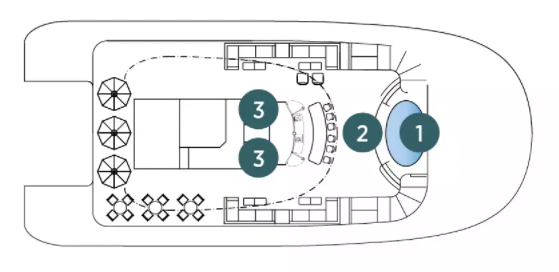





The images shown are for illustration purposes only and may not be an exact representation of what you find on the ship.
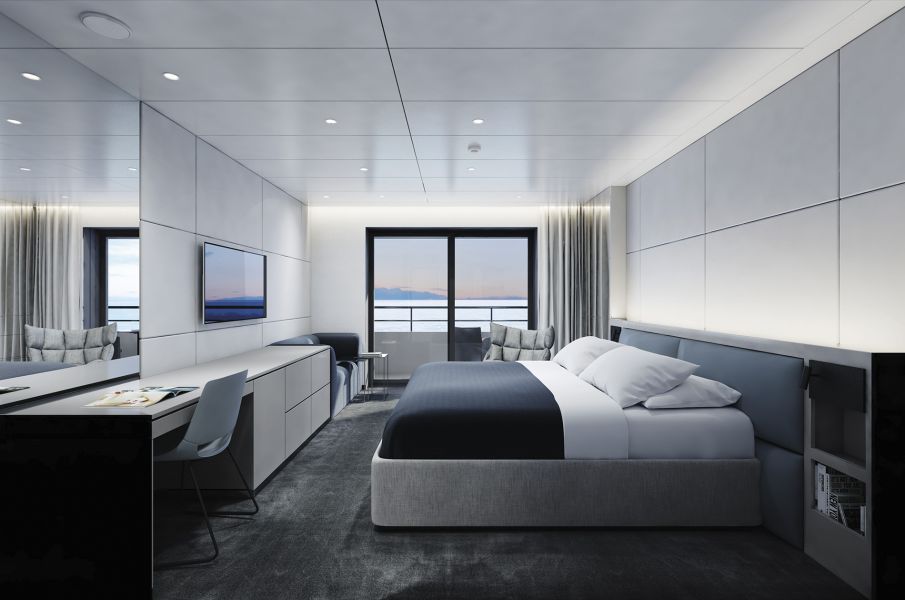
Divided between the Observation and Panorama decks, our Balcony Suites are your stylish home-away-from-home.
Featuring everything you’d expect from a world-class hotel, each one includes your own private balcony, from which to enjoy the stunning panoramas.
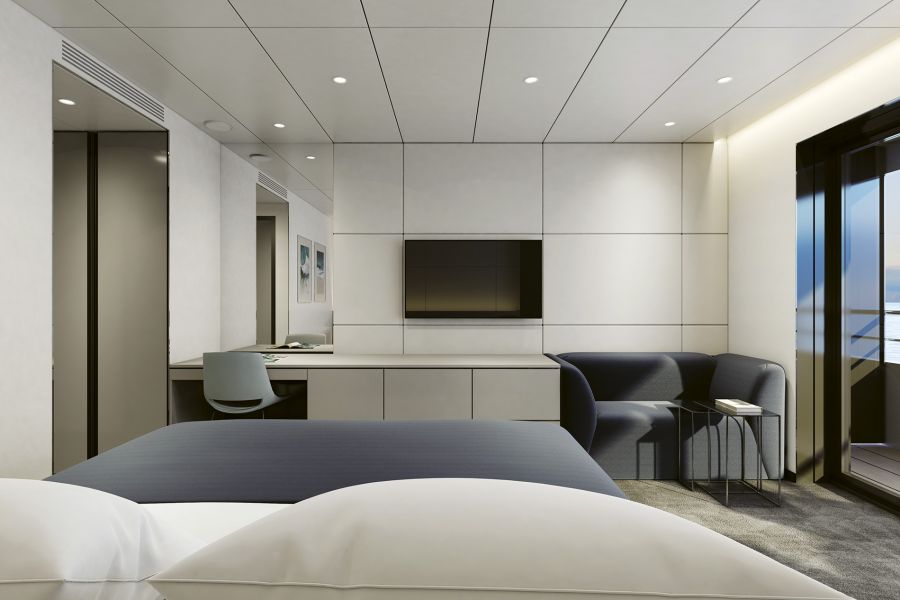
Situated on the Pool Deck, our two Deluxe Balcony Suites boast more space for your comfort.
Along with a private balcony, additional inclusions consist of coffee and tea-making facilities and a pillow menu for the perfect night’s sleep.

You’ll find six of our superb value Oceanview Staterooms on the Emerald Deck, situated towards the front of the yacht, each with their own ocean-view window.
Instantly settle in with our selection of included modern amenities and make the most of your close proximity to the Horizon Bar & Lounge.
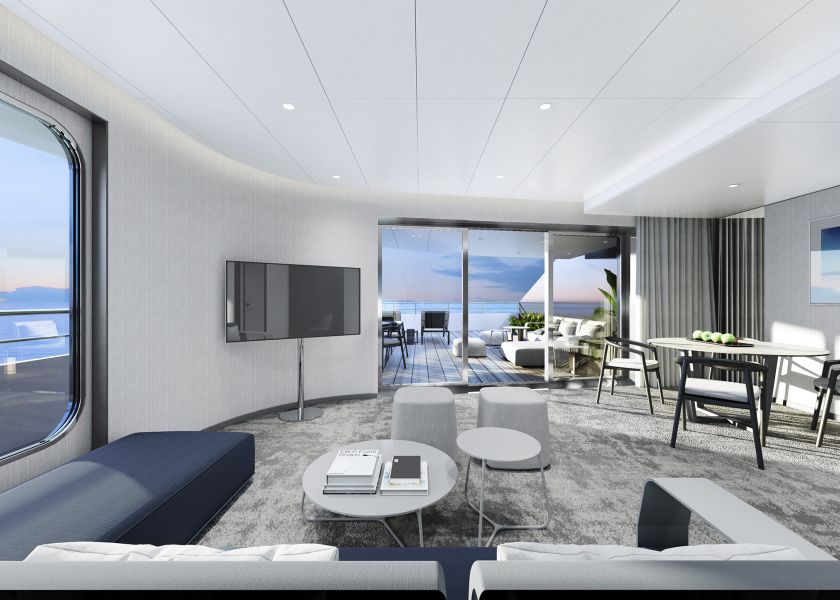
You’ll find our largest and most prestigious suites at the front of the Pool Deck, promising truly exceptional views of the unfolding landscapes.
A separate bedroom and lounge area gives you more room to roam, while a walk-in wardrobe and large private terrace encourage you to really settle into your boutique Owner's Suite.
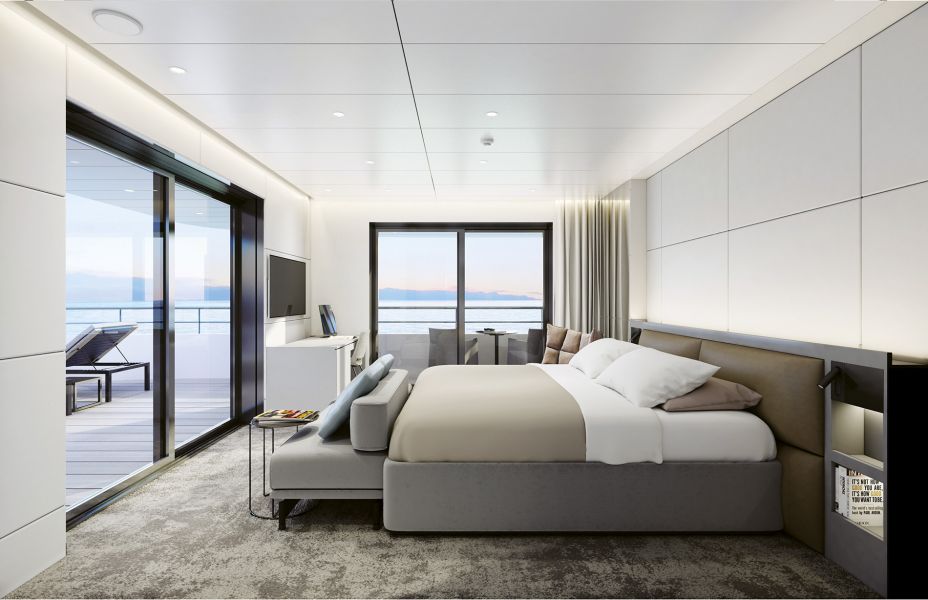
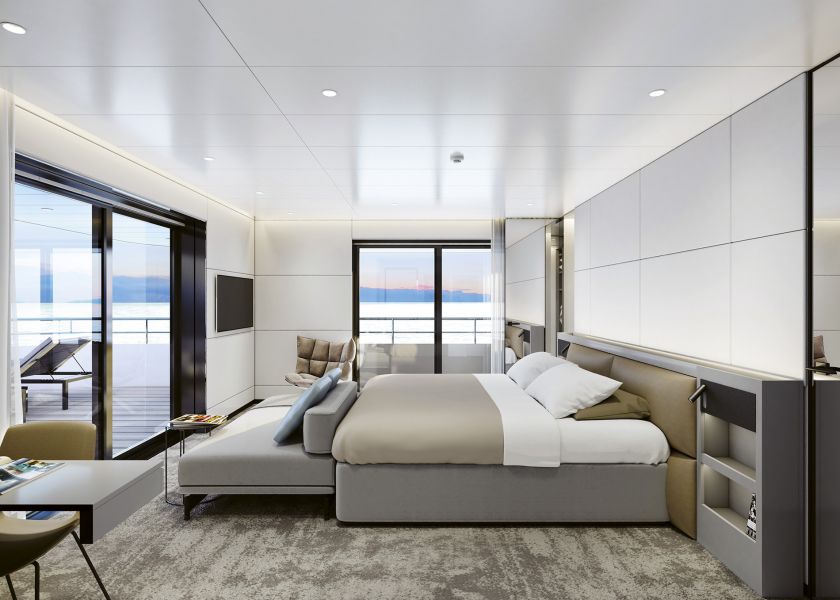
Wonderfully positioned at the back of the Observation Deck, you’ll be treated to sensational ocean and coastal views from your large private terrace.
Toast to your arrival with a complimentary bottle of champagne and a decadent fruit platter which will be waiting for you.
The images shown are for illustration purposes only and may not be an exact representation of what you find on the ship.
The images shown are for illustration purposes only and may not be an exact representation of what you find on the ship.
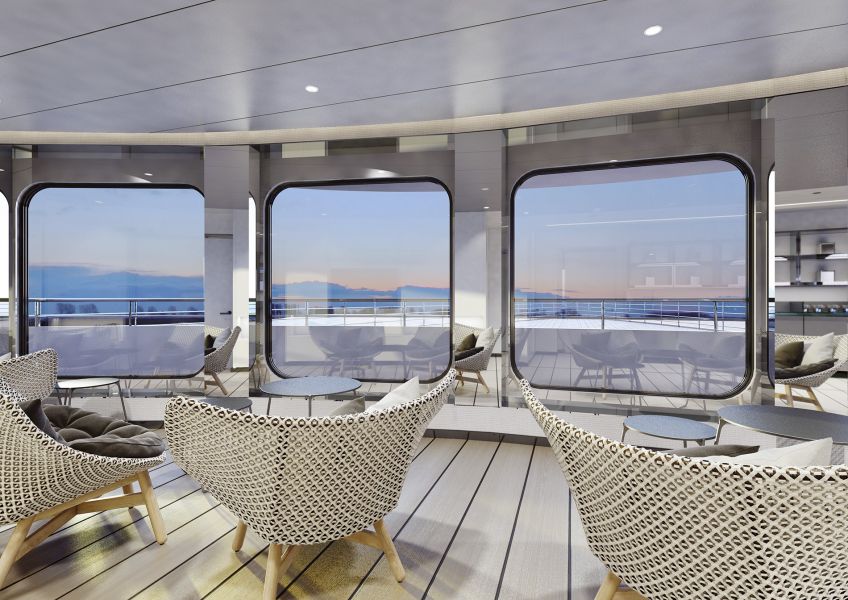
Head to the Observation Deck area for spectacular views or a morning yoga session. In the Observation Lounge, sit back and relax with a good book or play a game of chess.
The images shown are for illustration purposes only and may not be an exact representation of what you find on the ship.
The images shown are for illustration purposes only and may not be an exact representation of what you find on the ship.
| Return flights including luggage allowance | |||
| Overseas Transfers | |||
| 20 nights aboard the Emerald Sakara | |||
| Return airport transfers | |||
| Wine, beer & soft drinks with lunch & dinner | |||
| Gratuities Included | |||
| One complimentary shore excursion in every port | |||
| Bikes for passenger use | |||
| Free Wi-Fi included | |||
| Port Taxes and Fees | |||
 | ABTA and ATOL Protection* | ||
Fly/cruise package |
Date 15th Apr 2026 |
Nts 20 |
Interior  |
Oceanview £12,796pp |
Balcony  |
Suite £17,206pp |
Interior  |
Oceanview £25,592pp |
Balcony  |
Suite £30,002pp |
Date 15th Apr 2026 |
Nts 20 |
Interior  |
Oceanview £12,796pp |
Balcony  |
Suite £17,206pp |
Interior  |
Oceanview £25,592pp |
Balcony  |
Suite £30,002pp |




Fusion Cruises when selling travel arrangements is a trading name of The Midcounties Co-operative Ltd. Fusion Cruises is an Accredited Body Member of Midcounties Co-operative Travel Consortium. (ABTA:P6652, ATOL:6053).
Book with Confidence. We are a Member of ABTA which means you have the benefit of ABTA’s assistance and Code of Conduct.
Some of the flights and flight-inclusive holidays on this website are financially protected by the ATOL scheme but ATOL protection does not apply to all holiday and travel services offered on this website. This website will provide you with information on the protection that applies in the case of each holiday and travel service offered before you make your booking. If you do not receive an ATOL Certificate then the booking will not be ATOL protected. If you do receive an ATOL Certificate but all parts of your trip are not listed on it, those parts will not be ATOL protected. Please see our booking conditions for information, or for more information about financial protection and the ATOL Certificate go to: www.caa.co.uk
